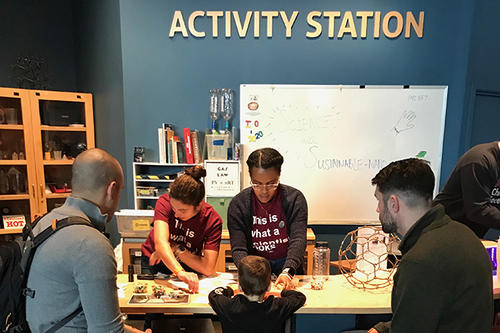
University of Minnesota Twin Cities researchers announced today that they are part of a team of researchers from the National Science Foundation (NSF) Center for Sustainable Nanotechnology who have received a five-year, $20 million grant from the NSF Division of Chemistry.
The grant will allow continued research on evaluating the molecular-level impact of nanotechnology on the environment and living things. The center was initially funded in 2012.
University of Minnesota Chemistry Professor Christy Haynes, a leading researcher in the growing field of sustainable nanotechnology, is the center’s associate director. The multi-institutional research center is based at the University of Wisconsin-Madison under the direction of Professor Robert Hamers.
“The NSF Center for Sustainable Nanotechnology stimulates my research group to approach scientific problems that we would likely never approach without the large-scale and long-term financial resources and collaboration that come with this opportunity,” said Haynes, a University of Minnesota Distinguished McKnight University Professor and Elmore H. Northey Professor. “For example, my group now has a significant interest in designing nanomaterials that will controllably chemically transform to release needed micronutrients to agricultural plants, aiming to increase crop yield and impact projected global food supply shortages.”
University of Minnesota Chemistry Associate Professor Erin Carlson is also a senior researcher within the center, and her research group is contributing to the overall center mission bringing her deep expertise in chemical biology and antibiotic resistance to the area of sustainable nanotechnology. For example, her team conducted a first-of-its-kind study showing that non-antibacterial nanoparticles can cause resistance in bacteria.
“Working with this scientifically diverse group of researchers has enabled us to rapidly push the boundaries in this field in ways that none of us could as individual laboratories,” Carlson said.
The NSF Center for Sustainable Nanotechnology has already had a broad impact on science research and will push toward exciting new chemistry insights in the coming five years.
“The NSF Centers for Chemical Innovation (CCIs) are transforming the way we do science by engaging interdisciplinary, multi-institutional teams to take on grand challenges in the field,” said David Berkowitz, Director of the NSF Division of Chemistry. “The NSF Center for Sustainable Nanotechnology, one of the CCIs, is performing important research that will guide the development of sustainable nanotechnologies, a key element of the industries of the future.”
The NSF Center for Sustainable Nanotechnology focuses on fundamental science and involves collaboration between researchers at the University of Wisconsin-Madison, University of Minnesota Twin Cities, nine other universities, and two government labs. Researchers apply what is learned, work to mitigate problems associated with nanomaterials, such as lithium ion batteries and other electronic waste, and design and synthesize nanomaterials which may offer benefits to the environment, such as those that improve plant health and reduce the need for pesticides and fungicides.
“Naturally occurring nanomaterials, like sand, are things to which our bodies and the environment have adapted,” said Hamers, a University of Wisconsin-Madison professor of chemistry and NSF Center for Sustainable Nanotechnology Director. “Engineered nanomaterials have not been in the environment for a long time, so biological systems have not adapted to challenges they present, leaving the potential for greater environmental impacts.”
Haynes pointed out that the NSF support also goes beyond the science. The grant to the NSF Center for Sustainable Nanotechnology supports five University of Minnesota graduate students per year in addition to undergraduates, equipment, and lab exchanges for University of Minnesota students to visit other NSF Center for Sustainable Nanotechnology institutions.
“The NSF Center for Sustainable Nanotechnology engages my students in professional development and science communication activities that make them well-rounded scientific leaders. I wish I'd been able to do my chemistry training in a center like this," Haynes said.
The University of Minnesota is also home to one of two NSF Center for Sustainable Nanotechnology leadership staff, Dr. Miriam Krause, who serves as the Director of Education and Outreach. Excellent examples of the NSF Center for Sustainable Nanotechnology’s outreach efforts include the Sustainable-Nano.com and Nano-sostenible.com blogs, which are written primarily by graduate students in the center.
The center is focused on chemical science, outreach and workforce development, serving as a strong professional development program for training graduate students, and incorporates a focus on improving diversity in STEM.
To learn more, visit the NSF Center for Sustainable Nanotechnology website.
- Categories:
- Science and Technology





